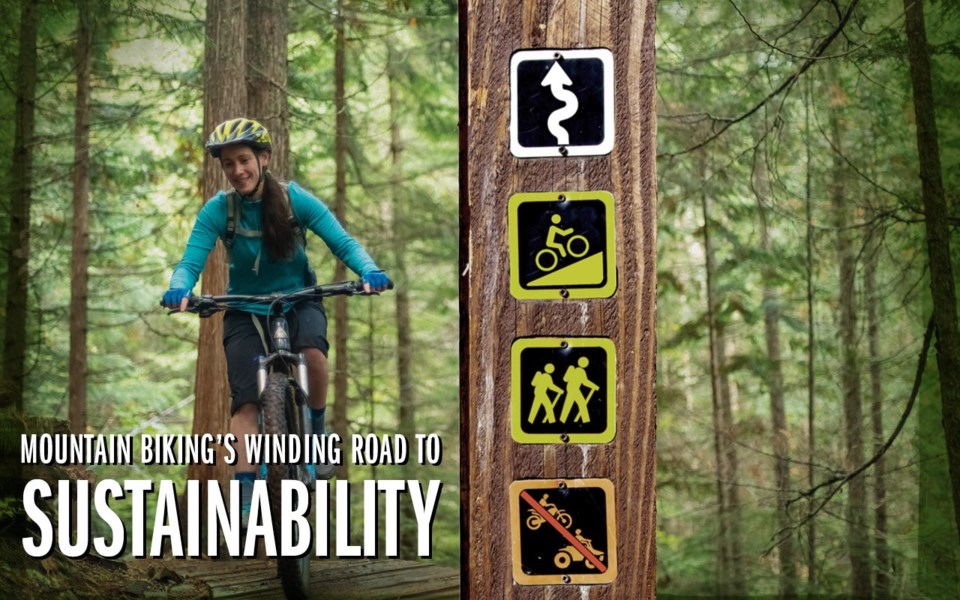
Mountain biking is all about hitting the sweet spot.
When riding, you want just the right line to get where you're going quickly, safely and enjoyably.
It's a similar tack in planning, as mountain bike operators and stakeholders try to navigate demands from various interested parties. That can even be the case when it comes to tourism, especially as the term "overtourism" is commonly bandied about these days.
But there's a subset of those in the tourism industry who think the lopsided distribution of those visitors is creating challenges in biking hotspots, while failing to share the wealth with places that would welcome guests with open arms, if only they'd come.
Under the broad umbrella of sustainability, the most recent Mountain Biking Tourism Symposium, held in Whistler at Dusty's and Legends Hotel from Oct. 2 to 4, tackled this topic and many others the industry is facing. All told, more than 200 club members, mountain biking and tourism industry representatives, conservationists, elected officials and more came out to discuss best practices for operating in a sustainable manner.
And while environmental sustainability might immediately jump to mind, there are other pillars to ponder, namely economic and social.
All three were on the docket during the biennial symposium.
Environmental
Though mountain bikers tend to be green-minded lovers of the outdoors, there are several environmental concerns that participants should consider in order to reduce the impact on trails and surrounding areas, as well as those that inhabit them.
Renowned grizzly bear researcher Dr. Lana Ciarniello of the Grizzly Bear Foundation and the International Union for the Conservation of Nature's Bear Specialist Group had a unique perspective on mountain biking's effects on grizzly bear populations, as her husband and son both avidly participate in the sport.
"I am not against mountain biking. I am for proper use of trails, proper trail planning," says Ciarniello, who presented on the conference's first day.
Ciarniello explains that any expansion of mountain biking into grizzly bear territory can have a negative impact on bear populations. One reason for this is grizzly bears actively avoid human contact. But finding unspoiled habitat requires a bear to expend energy, so it has to eat more to make up for the loss of fat, which can reduce birth rates. As well, bears tend to already be active in their chosen habitat, so when they are displaced, it is likely into a less desirable area.
"It's all about energy in, energy out, trying to get by," she says.
Ciarniello cites a 2004 U.S. Forest Service and State of Oregon study of elk wearing radio collars that found the animals were displaced, on average, 750 metres by biking activity (compared to 550 m for horseback riding and 1,350 m by ATVs), and noting that bears typically flee even further.
There are, of course, issues and conflicts when bears aren't given enough notice to avoid humans. Ciarniello notes that a grizzly is far more likely to attack when alerted to a human's presence within 50 m, and a study of conflicts discovered that 85 per cent of riders weren't aware of the grizzly's presence until they were within that distance. In the study, 29 of the 33 bears, or 88 per cent, charged. Four of those cases resulted in injury, with three requiring a hospital stay longer than 24 hours.
Ciarniello also sees the rise of e-bikes as another potential hazard. She notes that e-bikes increase the likelihood of conflict because of the higher speeds they can achieve, especially as e-bikers can travel significantly faster uphill into alpine bear habitat.
Ciarniello encourages riders of all kinds to prepare to meet bears in the wild, including slowing down and shouting when approaching blind curves, especially those with thick vegetation. Riders should never wear earbuds, and each rider in a group should carry bear spray in an easy-to-access place. One recommended option is KozeeTote, which is a modified water bottle holder, though this option is not effective when a rider is separated from his or her bike.
As well, items thought to be deterrents could actually be attractants, as she adds that bear spray only works in the moment and will attract bears once it has dissipated, and that bear bells can sound similar to birds, piquing a bear's curiosity.
Lastly, Ciarniello adds that off-leash dogs are the No. 1 reason for bear attacks in recent years. Dogs are a significant source of stress for bears, and there are the added variables of how each animal will react to one another, especially since riders won't know a bear's history of dog interactions.
In some cases, a dog will run back to its human owner and hide between its legs, leaving the rider vulnerable.
As organizations, Ciarniello suggests that for safety, clubs should be cognizant of where their trails lie in relation to bear territory, and should remove trails from running through critical habitats or, at the very least, manage them with closures and restrictions for important times of year for bears, like berry and glacier lily season, for example.
As alluded to earlier, with predictability a major necessity for bears, builders should avoid switchbacks and blind corners. As well, maintenance should include removing brush from trails and improving sight lines, as well as removing bear food and attractants from greenery near the trails.
There's also a connection between bear habitat and invasive species, as bears commonly disturb soil, which allows invasive species to take root in sensitive habitats.
Presenting alongside Ciarniello is Clare Greenberg of the Sea to Sky Invasive Species Council, who explains that the seeds of several invasive species like burdock burrs and knotweed are unwitting hitchhikers, as many can survive on shoes or in mud on bike tires.
Invasive species can have devastating consequences for ecosystems, as these species are only in check in their native habitats, but can run wild in new ones. Negative results from the introduction of invasive species include: wildlife habitat loss, biodiversity loss and monoculture growth, increased erosion and stream sedimentation, a decrease in land values as well as the quality and quantity of crops, and added property maintenance costs. Some invasive species, such as Scotch broom, can also increase wildfire risk, Greenberg says.
One particularly challenging element for mountain bikers is that many of the invasive species thrive in disturbed soil.
Greenberg's suggestions for stopping the spread of invasive species including arriving clean and leaving clean, meaning riders should hose down their bikes after every trip, scrubbing the pedals, derailleur and chain, and wiping one's shoes. While these tips are important when moving from region to region, it's also key when moving up into sensitive ecosystems such as the alpine.
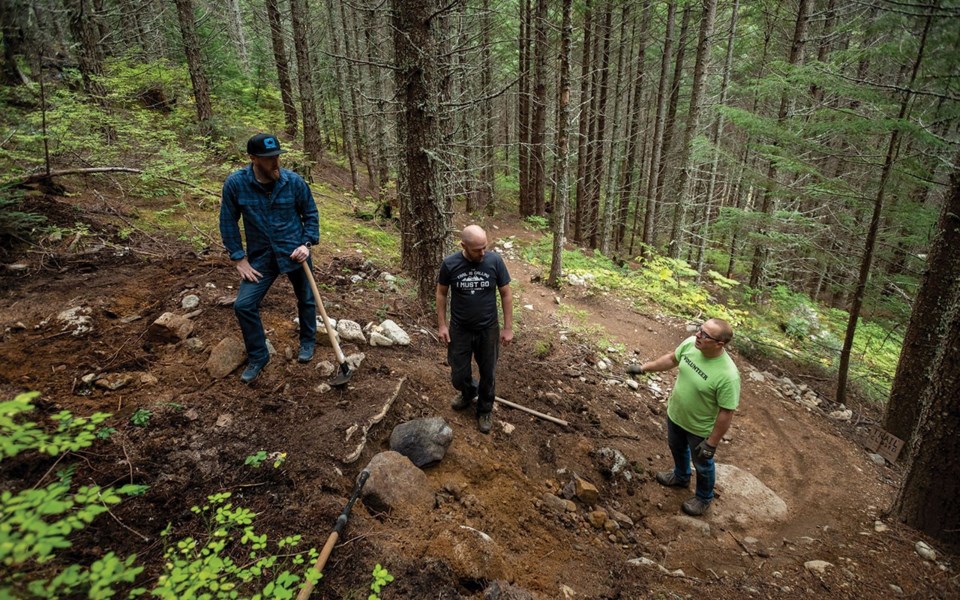
Social
While environmental sustainability should certainly be a priority for the mountain bike industry, the concept of "social sustainability" shouldn't be ignored either, says Justin Darbyshire of IMBA Canada and the Aboriginal Youth Mountain Bike Program.
More than just selling the quality of riding in a destination, Darbyshire says selling it as somewhere people want to be is just as essential.
It's important for mountain bikers, who for the most part are tourists in some capacity, to relinquish some of the feeling of ownership from the trails, moving from calling them "my trails" or "our trails" to "the trails," Darbyshire says.
"Mountain bike trails are a public good. They're on public land. When they're legal, they're funded by public money," he says. "We need to take ownership for what we're riding and take ownership for what we do, but unleash that trail system. Everyone wants to come ride it.
"We're sharing them."
As well, Darbyshire explains, goings-on in one part of the province affect what happens in another. Therefore, the mountain biking community must broaden its vision of who should be included in the group.
"A strong community is held together by something. There's a shared vision, a shared entity of some sort," he says, noting a strong community has people of different ages, vocations, backgrounds, and ability levels.
Of course, more voices can lead to more conflict. Being more inclusive of all riding abilities likely means putting more of the already limited resources available toward green and blue trails, or revamping what already exists, pushing some members back to rogue building.
Darbyshire stresses that members must find a shared commonality based not just on geography but culture, values and history. And, of course, it's going to be impossible to get absolutely everyone on board.
Instead of forcing or guilting members into coming out, clubs should focus primarily on who already wants to be there, and eventually, word will spread.
As an example, while heading up the club in Kelowna, Darbyshire described the organic, unforced development of cyclocross.
"We started with 12 people, and we would do it every Thursday night with 12 people. The next year, we had 30 people, and the next year, we had 70 people," he recalls. "We topped out at about 80, from nothing, and what we did is we didn't give a fuck. We did it anyways. We didn't care if anybody came out.
"We're like, 'Yes, we're dumb, it hurts, it sucks, it's painful,' and people started coming. [Road riders] who were like 'That sport is stupid,' started showing up."
Darbyshire wrapped by urging riders to connect with one another and replicate what's working for their own communities. As well, he says, it's imperative to spread the message to as far and wide as possible.
"Anyone wearing a pair of shoes is a potential supporter of trails in your community. It starts there," he says.
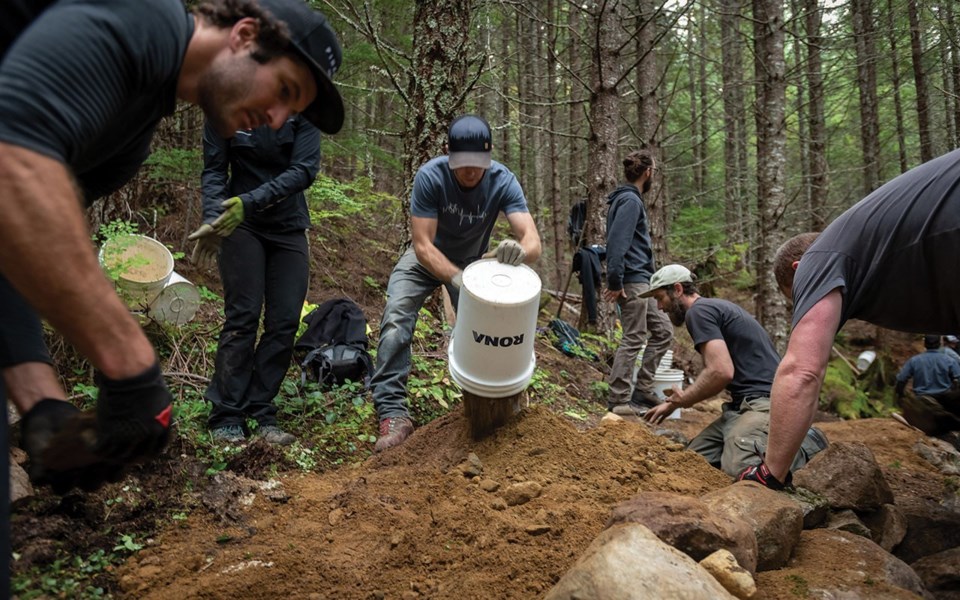
Whether they're long-term residents or recent arrivals, bikers congregate around the sport and build their social networks around it. In addition to being a draw, quality trails can be another reason to stay.
"People are proud of where they come from, and I think in the past, that wasn't necessarily the case," Jeff Norman of the Squamish Off-Road Cycling Association (SORCA) says during a sustainable mountain biking panel.
Of course, it's impossible to consider mountain biking without access to trails on unceded traditional Indigenous territory. Louise Pederson of the Outdoor Recreation Council of B.C. says it is of the utmost importance to engage in and live in a way that supports reconciliation.
She encourages stakeholders to get to know their local First Nations, listening to their needs and concerns and, when relevant, taking no for an answer.
Economic
Of the three pillars of sustainability that make mountain biking happen, the economic has long been at the forefront.
But different clubs and stakeholders aren't always at the same stage in their respective development, making symposiums like the one in Whistler crucial to getting everyone on the same page.
Some of the more progressive clubs were putting a pin in a long-time goal of countless organizations, explaining how the dream of government support might not be all it's cracked up to be.
There are several reasons for this.
Firstly, there can be a perception in the community that because there is funding for trails, that means municipal workers are getting paid to maintain the trails with no volunteers required. It's imperative, then, to get the message out that, for many clubs, the lion's share of the work is off the backs of those donating their time and efforts.
"People just started to come and they started to tell other people about it," says Aleksa Havelaar of the Terrace Off-Road Cycling Association (TORCA). "People start to realize that there isn't a city worker getting paid.
"People started to learn that all these trails they've been riding on are built by volunteers."
Hillier explains that there is plenty of money to draw from within the mountain biking community, but the way it currently moves around tends to be difficult to follow. He explains that the North Shore Mountain Biking Association is looking to move away from government funding as, in his view, the municipality sometimes treats an organization like a contractor or employee, making it difficult to push back on some of its decisions.
"Taking money from them can challenge the relationship," Hillier says.
Norman, of Squamish, adds that the optics can be bad at times if SORCA receives government funding to maintain some of its 250 km of trails, but other worthy recipients such as the Howe Sound Women's Centre receives less or no funding at all.
The most striking challenge is that after these trail networks are built and maintained, there are few ways to recoup the costs that went into them.
Among the approaches clubs are currently taking is to lean into user-pay models through memberships and by encouraging visiting riders to make a contribution to the club, as well as bypassing government altogether by attracting funding from the private sector.
In addition to having its own financial concerns, biking can be used as a draw that local companies can use to attract workers. TORCA's Havelaar notes that some employers in the northern, resource-based town will include a trail ride as part of its interview process in an attempt to draw professionals.
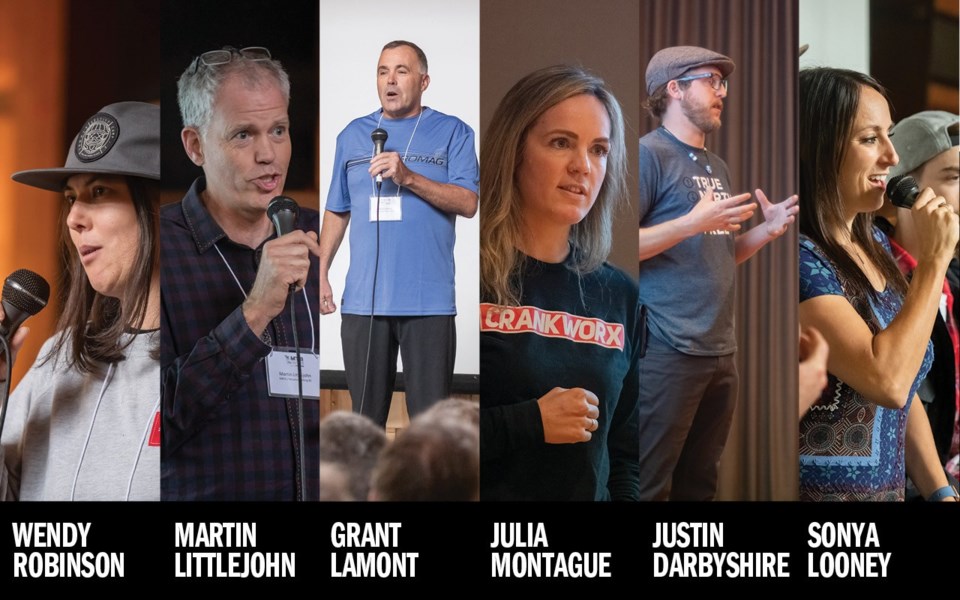
Whistler's place in the mountain biking world
With the symposium taking place in Whistler, several local leaders had the opportunity to stand up and explain their views and roles in the ever-changing industry.
The conference started with the Whistler Mountain Bike Park's Wendy Robinson, Resort Municipality of Whistler's Mike Furey, Tourism Whistler's Barrett Fisher and Whistler Off-Road Cycling Association's Dale Mikkelsen taking part in a panel moderated by Grant Lamont of Whistler Bike Guides. Other local presenters included Whistler bike park manager Brad White and Crankworx's Julia Montague, who pushed for better communication between pro riders and the communities they choose to ride in, as countless athletes who come for Crankworx will explore other trails across the province while they're here in Canada before or after the festival.
With the Crankworx marketing machine putting the focus on B.C., Montague says, the time for surrounding communities to strike is nigh.
As a rider herself for the past eight years, much of Montague's interest in traveling to destinations has been stoked by major races held in locales ranging from Ireland and Italy to New Zealand and Australia. She's also landed on a mountain biking site for an upcoming vacation to Mexico.
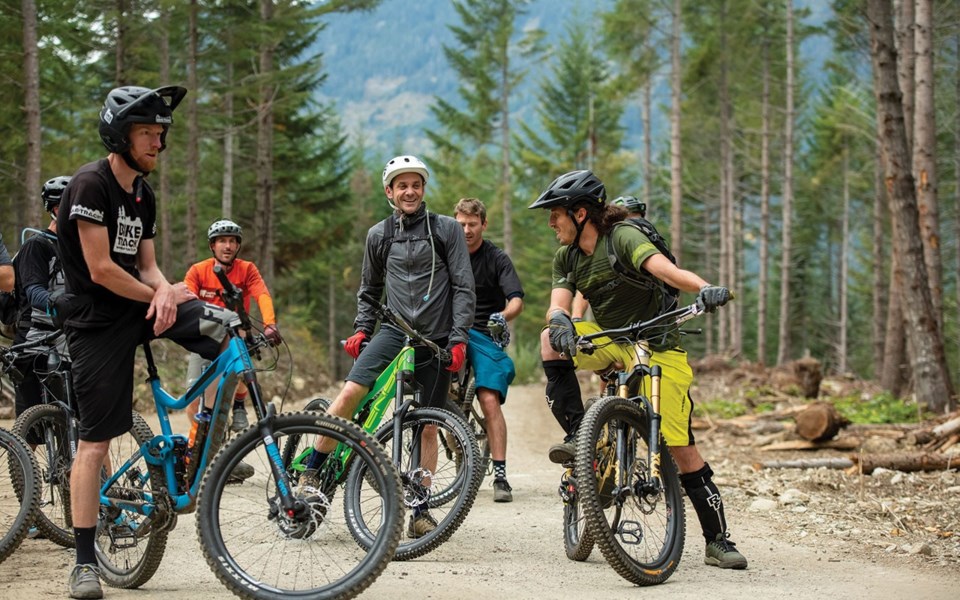
"Interestingly, all of these places that I have travelled to ride are all because they have hosted events," she says.
It starts with the festival and keeping athletes happy. Stoked athletes, she reasons, bring industry media, and through that dissemination, visitors, guests and fans come out, with the sponsors eventually following suit.
At a time when some B.C. towns are hurting because of the loss of resource jobs, Montague pointed to the Western Australia town of Derby, which was a tin-mining hub before it lost its mine in a flood. In 2015, however, the town received government funding for trails, and by 2017, was hosting Enduro World Series races. The town now has roughly 100 people working in the mountain biking industry as a serious economic driver.
Meanwhile, the Tasmanian town of Maydena, where the jobless outnumbered the employed before its mountain bike park opened in January 2018. In less than two years, it is now Australia's largest bike park, and the town's weekend population doubles from its starting point of 225.
Lorence's advice, meanwhile, was reinforcing the importance of quality trails, noting there's nothing worse than going to the trouble of planning a trip only to find lacklustre riding. As well, tourism boards should sit front and centre in supporting the trip, helping media members connect to guides in order to highlight the crème de la crème of a community.
Montague says tapping into Crankworx's guests would help promote B.C.'s smaller communities in a big way.
"When you have a central hub for all that information to live, that makes it easier to put those types of trips together," she says. "We have a lot of potential to do the same thing for these 1,300 athletes and 300 media [members] who are here already."
Where to go from here
As the symposium winds down after the last speaker, there are pockets of conversations all around the Dusty's dining room. What's important, says Martin Littlejohn, associate executive director for the Western Canada Mountain Bike Tourism Association, is that the presentations aren't the end of the discussion, but just the beginning.
It's a pattern he's noticed in years prior, as the symposium reconvenes every two years after there has been marked progress on initiatives stemming from the previous event. The 2017 meeting in Revelstoke, for example, started with confusion and concern about the role of e-bikes in the sport, and how clubs, governments, landowners and other stakeholders would handle their usage. Flash-forward two years and land managers such as BC Parks, Recreation Sites and Trails BC, and countless municipalities have policies in place, though they continue to regularly monitor the effects of e-bikes on those trails.
"E-bikes were considered to be an unknown and there was a lot of concern in Revelstoke about what it was going to mean. The province has responded with some policies. It's not perfect, by any means, yet. It's [still in its] very early stages, but at least there's a bit of a pace going now," Littlejohn says in an interview as attendees clear out of Dusty's and prepare for the final group ride of the week.
With the camaraderie, consultation and connections forged at this year's Mountain Biking Tourism Symposium, it will be interesting to see what kind of progress has been made on the above sustainability challenges when the band gets back together in 2021.
While sustainability is on the menu this time, attempts to develop and grow the sport are never entirely off the table, as Littlejohn notes during his initial address.
"We have an entire province, and the challenge going forward is trying to leverage our partners in the provincial and the federal governments to open up that Crown land," Littlejohn says.
Certainly, the more options, the better, but it remains to be seen whether dispersing or concentrating riders is the ideal option.
To view some of the speakers' PowerPoint presentations from the event, visit http://mtbtourismsymposium.ca.



